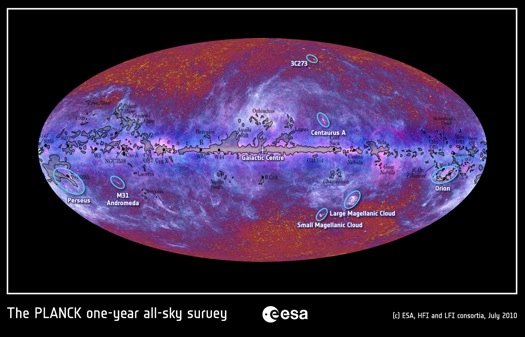The Planck Satellite was launched in May 2009, and started regular operations late last summer. This spring, we achieved an important milestone: the satellite has observed the whole sky.
To celebrate, the Planck team have released an image of the full sky. The telescope has detectors which can see the sky with 9 bands at wavelengths ranging from 0.3 millimeters up to nearly a centimeter, out of which we have made this false-color image. The center of the picture is toward the center of the Galaxy, with the rest of the sphere unwrapped into an ellipse so that we can put it onto a computer screen (so the left and right edges are really both the same points).
At the longest and shortest wavelengths, our view is dominated by matter in our own Milky Way galaxy — this is the purple-blue cloud, mostly so-called galactic “cirrus” gas and dust, largely concentrated in a thin band running through the center which is the disk of our galaxy viewed from within.
In addition to this so-called diffuse emission, we can also see individual, bright blue-white objects. Some of these are within our galaxy, but many are themselves whole distant galaxies viewed from many thousands or millions of light years distance. Here’s a version of the picture with some objects highlighted:

Even though Planck is largely a cosmology mission, we expect these galactic and extragalactic data to be invaluable to astrophysicists of all stripes. Buried in these pictures we hope to find information on the structure and formation of galaxies, on the evolution of very faint magnetic fields, and on the evolution of the most massive objects in the Universe, clusters of galaxies.
But there is plenty of cosmology to be done: we see the Cosmic Microwave Background (CMB) in the red and yellow splotches at the top and bottom — out of the galactic plane. We on the Planck team will be spending much of the next two years separating the galactic and extragalactic “foreground” emission from the CMB, and characterizing its properties in as much detail as we can. Stay tuned.
I admit that I was somewhat taken aback by the level of interest in these pictures: we haven’t released any data to the community, or written any papers. Indeed, we’ve really said nothing at all about science. Yet we’ve made it onto the front page of the Independent and even the Financial Times, and yours truly was quoted on the BBC’s website. I hope this is just a precursor to the excitement we’ll generate when we can actually talk about science, first early next year when we release a catalog of sources on the sky for the community to observe with other telescopes, and then in a couple of years time when we will finally drop the real CMB cosmology results.

One response to “The Planck Sky Previewed”
It is a pretty stunning image.